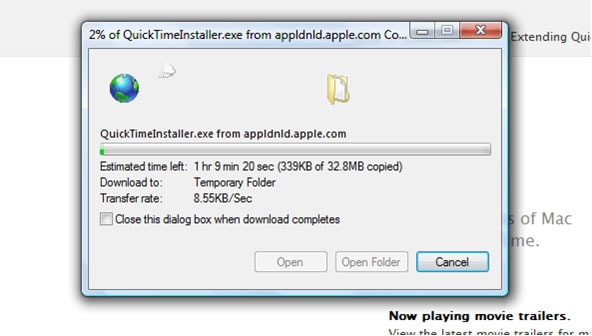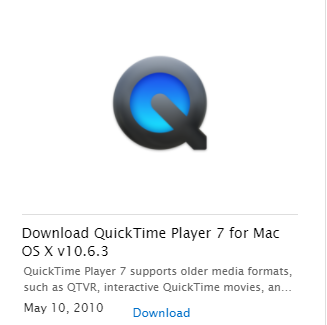
#QUICKTIME WEB PLUGIN DOWNLOAD#
Open these in QuickTime X Player and do a Get Info and you'll see that they are both H.264/AAC.Īlternatively, you could download them and analyze them with a more robust tool such as MediaInfo. The version that calls on the QuickTime Plug-in is exactly the same as the one that uses HTML 5. It's true that this video was originally Matroska but it was re-encoded to H.264 by Handbrake. Not sure where you are getting the Matroska labeling from. Theora would be another version that Firefox likes. Thus, Safari and Chrome play the H.264 version and Firefox plays the WebM version. The way HTML 5 video playback works is that the browser plays the first video it can play. Safari should not have any problem with the HTML 5 code. In fact, QuickTime X Player now converts old video files using a routine called the Video Modernizer. For example, Perian has ceased development because QuickTime X Player no longer uses it.
#QUICKTIME WEB PLUGIN SOFTWARE#
Unfortunately, the world of web video has changed so the way that older software worked is no longer relevant. So, this is the question: Why does Safari throw a "Plug-in failure" message on one OS X 10.10.3 machine and not on another?įBTW, I have also turned off all Safari extensions and booted into Safe mode, all to no avail.įirst of all, thanks so much for looking at this. However, this issue with Safari and the QuickTime Plug-in seems to affect some Macs and not others even though those Macs are all using the same OS and the same version of Safari.
#QUICKTIME WEB PLUGIN CODE#
So, yes, web authors will eventually have to re-write the code for video on their web sites, if only because Chrome refuses to use the QuickTime (and, presumably) other plug-ins. The reason for this alternate version is the Firefox refuses to play H.264 video natively. This alternate video is in *.webm format.

If you look at the code for that page, you'll note that there is a second, alternate version of the video. It plays natively in all browsers on all of the machines available to me. It DOES NOT use the QuickTime Plug-in at all.

The second instance of the same video file uses the HTML 5 video tag. Firefox demands that QuickTime be "activated" on every play and does not begin playback until the entire file has been downloaded (no progressive streaming aka fast start) but FF does eventually play it. Chrome refuses to play it at all saying that this (QuickTime) Plug-in is not supported.

My laptop, also on OS X 10.10.3, DOES play this video. My desktop computer (OS X 10.10.3) gets a Plug-in failure error message with Safari. The one that requires the QuickTime Plug-in uses modern CODECs (H.264 and AAC) so " legacy" CODECs are not the issue. H.264/AAC - uses QuickTime Plug-in embed code: I have even attempted to replace the QuickTime Plug-in with a copy of the same file from my laptop. I have fiddled with Security Safari prefs to no avail. I have booted into recovery and run every corrective measure I can think of (permissions, disk repair, etc.). Thus, its clear to me that the problem is specific to my desktop machine. Since Safari 8.0.6 under OS X 10.10.3 is my primary web browser on my desktop system and I am getting the Plug-in failure error message whenever I encounter video instantiated with QuickTime embed code, my question is how do I correct this situation? My laptop does not display this issue even though it also uses Safari 8.0.6 under OS X 10.10.3. Safari: On some current systems, Safari will throw a "Plug-in failure" message and refuse to play the video. FF will make this demand for every instance. After doing so, FF downloads the entire video before beginning to play. Encountering a web site that addresses the legacy QuickTime Plug-in with embed code using the latest popular web browsers has the following negative effects:įirefox: Activate QuickTime.


 0 kommentar(er)
0 kommentar(er)
